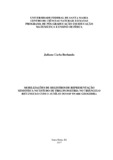| dc.creator | Berlanda, Juliane Carla | |
| dc.date.accessioned | 2018-06-25T21:34:53Z | |
| dc.date.available | 2018-06-25T21:34:53Z | |
| dc.date.issued | 2017-10-27 | |
| dc.identifier.uri | http://repositorio.ufsm.br/handle/1/13533 | |
| dc.description.abstract | This research aimed to answer the following question: “How are the registers of semiotic representation mobilized in the approach of right triangle trigonometry with the help of the GeoGebra software, based on a sequence of activities with students of the 1st grade of high school?”. The sequence of activities was designed with an investigative conception, using the technological resource of GeoGebra, and was developed with a class of students of a public school in Erechim, in the state of Rio Grande do Sul, Brazil. This research is supported by the learning theory of registers of semiotic representation and constituted based on the Didactic Engineering methodology. Data collection was carried out through printed materials, files recorded with the software, and audio media containing the speeches of the students during the interventions. This material was analyzed considering the following categories: a) through mathematical experimentation and the consequent coordination of the various representations made possible by the dynamicity of GeoGebra resources, a program in which several semiotic representations were coordinated (natural language, figural, tabular, numerical, algebraic and symbolic), as well as the analysis of apprehensions (perceptual, discursive and operative); b) by proposing an exploratory approach in mathematics education, based on an environment of dynamic geometry and a sequence of activities with an investigative conception, in which the student‟s autonomy was verified in the accomplishment of the proposed activities, provided by the ease of manipulation of mathematical objects elaborated in GeoGebra; c) through the encouragement of mathematical communication in the classroom, through the preparation of written and verbal justifications, when the natural language register became evident, with the verification of the subjects‟ knowledge acquisition. In addition, the stages of Didactic Engineering, as well as its reflections, were recognized as fundamental for the development of this research and the elaboration of the sequence of activities. In the analysis of the results, it was verified that the students were able to acquire knowledge about the study of right triangle trigonometry. | eng |
| dc.language | por | por |
| dc.publisher | Universidade Federal de Santa Maria | por |
| dc.rights | Attribution-NonCommercial-NoDerivatives 4.0 International | * |
| dc.rights.uri | http://creativecommons.org/licenses/by-nc-nd/4.0/ | * |
| dc.subject | Trigonometria no triângulo retângulo | por |
| dc.subject | GeoGebra | por |
| dc.subject | Registros de representação semiótica | por |
| dc.subject | Engenharia didática | por |
| dc.subject | Right triangle trigonometry | eng |
| dc.subject | GeoGebra | eng |
| dc.subject | Registers of semiotic representation | eng |
| dc.subject | Didactic engineering | eng |
| dc.title | Mobilizações de registros de representação semiótica no estudo de trigonometria no triângulo retângulo com o auxílio do software GeoGebra | por |
| dc.title.alternative | Mobilizations of records of semiotic representation in the study of trigonometry in triangle rectangle with the aid of GeoGebra software | eng |
| dc.type | Dissertação | por |
| dc.description.resumo | Esta pesquisa procurou responder a seguinte questão: “Como os registros de representação semiótica são mobilizados na abordagem de trigonometria no triângulo retângulo com o auxilio do software GeoGebra, a partir de uma sequência de atividades com alunos do 1º ano do ensino médio?”. A sequência de atividades foi elaborada com um caráter investigativo, tendo sido utilizado o recurso tecnológico GeoGebra e dinamizada junto a uma turma de alunos de uma escola da rede pública estadual do município de Erechim, RS. Esta pesquisa está amparada pela teoria de aprendizagem de registros de representação semiótica e constituída a partir da metodologia da Engenharia Didática. A coleta de dados foi realizada por meio de material impresso, arquivos gravados com o software e mídias de áudios contendo as falas dos estudantes durante as intervenções. Este material, foi analisado considerando-se as seguintes categorias: a) Por meio da experimentação matemática e consequente coordenação das diversas representações viabilizadas pela dinamicidade oportunizada pelos recursos do GeoGebra, onde ocorreu a coordenação de diversas representações semióticas: língua natural, figural, tabular, numérica, algébrica e simbólica; além da análise de apreensões: perceptivas, discursivas e operatórias; b) Mediante a proposição de uma abordagem exploratória no ensino de matemática, pautada em um ambiente de geometria dinâmica e numa sequência de atividades com caráter investigativo, onde constatou-se a autonomia dos alunos na realização das atividades propostas, proporcionadas pela facilidade de manipulação dos objetos matemáticos elaborados no GeoGebra; c) Por meio do incentivo a comunicação matemática em sala de aula mediante a elaboração de justificativas escritas e verbais, ficando evidente o registro em língua natural onde ocorreu a verificação da obtenção do conhecimento do assunto. Também, reconheceu-se como fundamental para o desenvolvimento desta pesquisa e da elaboração da sequência de atividades as etapas presentes na engenharia didática junto de suas reflexões. Sendo que, na análise dos resultados constatou-se que foi viabilizada aos alunos a aquisição de conhecimentos relativos ao estudo de trigonometria no triângulo retângulo. | por |
| dc.contributor.advisor1 | Ferreira, Inês Farias | |
| dc.contributor.advisor1Lattes | http://lattes.cnpq.br/0979050331045936 | por |
| dc.contributor.referee1 | Richit, Adriana | |
| dc.contributor.referee1Lattes | http://lattes.cnpq.br/2107707592550055 | por |
| dc.contributor.referee2 | Mariani, Rita de Cássia Pistóia | |
| dc.contributor.referee2Lattes | http://lattes.cnpq.br/8330933788557081 | por |
| dc.creator.Lattes | http://lattes.cnpq.br/5574153702944501 | por |
| dc.publisher.country | Brasil | por |
| dc.publisher.department | Educação | por |
| dc.publisher.initials | UFSM | por |
| dc.publisher.program | Programa de Pós-Graduação em Educação Matemática e Ensino de Física | por |
| dc.subject.cnpq | CNPQ::CIENCIAS HUMANAS::EDUCACAO | por |
| dc.publisher.unidade | Centro de Ciências Naturais e Exatas | por |



